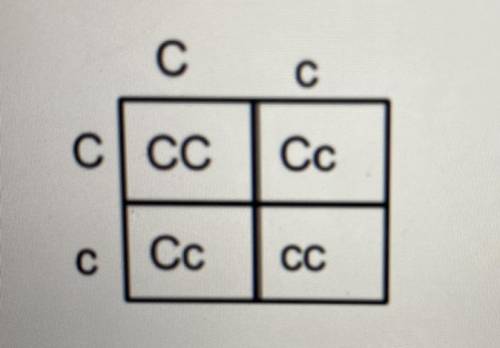
Biology, 11.01.2021 08:40 eileentennyson
For a particular trait, the allele C is dominant over the allele c. The Punnett square below shows
the genetic
С
с
Сс
ССС
ccc
CC
6. What percentage of the offspring will show the phenotype of the dominant and
recessive allele?
A. 50% will show the phenotype of the dominant allele and 25% will show the
phenotype of the recessive allele.
B. 75% will show the phenotype of the recessive allele and 25% will show the
phenotype of the dominant allele.
C. 75% will show the phenotype of the dominant allele and 25% will show the
phenotype of the recessive allele
D. 100% will show the phenotype of the dominant allele and 0% will show the
phenotype of the recessive allele.


Answers: 1


Other questions on the subject: Biology

Biology, 21.06.2019 23:00, hannahkharel2
The dna in a cell’s nucleus encodes proteins that are eventually targeted to every membrane and compartment in the cell, as well as proteins that are targeted for secretion from the cell. for example, consider these two proteins: phosphofructokinase (pfk) is an enzyme that functions in the cytoplasm during glycolysis. insulin, a protein that regulates blood sugar levels, is secreted from specialized pancreatic cells. assume that you can track the cellular locations of these two proteins from the time that translation is complete until the proteins reach their final destinations. for each protein, identify its targeting pathway: the sequence of cellular locations in which the protein is found from when translation is complete until it reaches its final (functional) destination. (note that if an organelle is listed in a pathway, the location implied is inside the organelle, not in the membrane that surrounds the organelle.)
Answers: 3


Biology, 22.06.2019 07:20, boo8181
Agroup of plant cells was exposed to radiation, which damaged the chloroplasts and caused them to lose function. if the mitochondria were unharmed, what would happen to the overall function of the plant cells? a. the cells would not be able to make food, but would be able to release energy from biomolecules. b. the cells would not be able to replicate dna, but would be able to break down waste. c. the cells would not be able to break down waste, but would be able to replicate dna. d. the cells would not be able to release energy from biomolecules, but would be able to make food.
Answers: 1

Biology, 22.06.2019 22:30, BrainlyAvenger
According to the article, what valid claim came from the national research council? there is no association between fluoride exposure and increased cancer risk in humans. there is a possible link between fluoride exposure and increased cancer risk in humans. there is a definite link between fluoride exposure and increased cancer risk in humans.
Answers: 1
You know the right answer?
For a particular trait, the allele C is dominant over the allele c. The Punnett square below shows...
Questions in other subjects:


Mathematics, 03.07.2020 14:01


English, 03.07.2020 14:01




Chemistry, 03.07.2020 14:01

Mathematics, 03.07.2020 14:01



